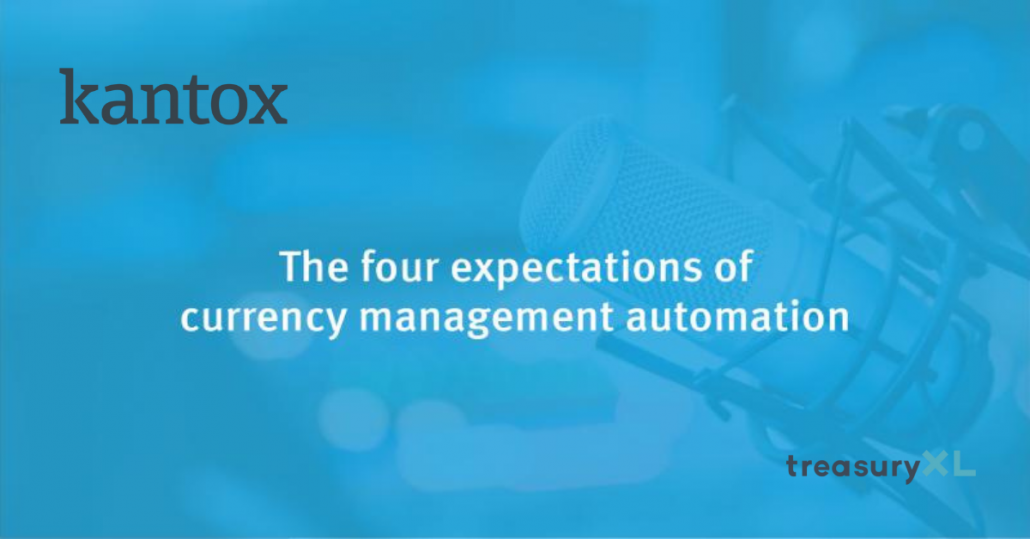The four expectations of Currency Management Automation
14-02-2022 | treasuryXL | Kantox | LinkedIn |
With FX volatility intensifying and exposing companies to even greater currency risk, treasurers & CFOs are faced with many challenges as they look to step up their FX risk management strategy. The key to this is currency management automation, but what are the critical problems an automated solution needs to solve to become a worthwhile tool in your treasury kit?
Click on the image above for the corresponding episode of CurrencyCast
The four main expectations of currency management automation for CFOs and treasurers are:
- The need to improve time management
- To remove operational risks
- To improve the efficiency of treasury operation
- To place themselves in a position to make a strategic contribution in terms of enhancing the value of the firm
Challenge 1: Improving time management
According to the 2021 HSBC Corporate Risk Management survey, 55% of treasurers say FX risk management takes up most of their time; and 44% find that automation frees up time. Throughout the FX workflow, members of the finance team manually execute many tasks. These are repetitive, time-consuming and add little value. The French have a wonderful expression to define those tasks: they call them chronophage — literally, they eat away your time. With more time at their disposal, treasurers could focus on more value-adding activities, such as improving and fine-tuning their forecasts.
Challenge 2: Removing operational risks
Throughout the FX workflow, operational risk is omnipresent. Operational risk is the risk that inadequate or failed internal processes can pose to your business. Take spreadsheet risk. From the moment an FX rate is sourced for pricing purposes to the budgeting process, and all the way to the cash flow moment of the post-trade phase, dozens, hundreds, perhaps thousands of spreadsheets circulate across the enterprise, magnifying the risk of manual data input error.
A recent Citi Corporate Treasury survey showed that 80% of FX risk managers remain reliant on Microsoft Excel. In our conversations with CFOs and treasurers, we noted that often, a handful of people or even sometimes a single individual is in charge of executing most –if not all– the tasks of FX risk management across the entire enterprise. These enterprises can often comprise of subsidiaries, each with its own set of currency pairs. This is the very definition of key person risk.
Taken together, spreadsheet risk and key-person risk are part of operational risks that can cause serious damage to your FX risk management strategy.
Challenge 3: Improving the efficiency of treasury operations
According to this same Citi Corporate Treasury survey, efficiency gains in treasury is the number one expectation of technology. There is a myriad of ways in which the efficiency of treasury operations can be improved in FX risk management.
Consider most Treasury Management Systems (TMS) shortcomings, even those with FX capabilities. Looking at the FX workflow, most TMS are incapable of proactively helping risk managers execute their tasks. Why though?
(a) They lack a robust rate feeder that allows the business to price with the forward rate when forward points are in favour or ‘against’.
(b) They are adequate for balance sheet hedging, but they fail to capture the type of exposure needed in cash flow hedging (e.g. forecasted exposure for individual campaigns/budget periods in static hedging; forecasted exposures for sets of campaigns/budget periods linked together for layered hedging etc. ),
(c) They lack the level of automation –during the cash flow moment of the post-trade phase of a hedging program– needed to efficiently handle the adjustment of hedges to the underlying cash flows.
Challenge 4: The need to make a strategic contribution in terms of enhancing value
HSBC’s survey showed that only 23% of treasurers see themselves as ‘best-in-class’ when it comes to FX hedging. With FX risk firmly under control thanks to a family of automated hedging programs and combinations of hedging programs, CFOs and treasurers would be in a position to:
(a) Diminish the variability of corporate performance
(b) Secure and enhance operating profit margins
(c) Improve the competitive position of the firm
(d) Make more efficient use of invested capital by boosting the sales/capital ratio and by minimising the amount of capital that needs to be set aside for collateral and margin requirements
Improving time management and removing operational risks are the most visible, the most tangible expectations of currency management automation, but they might not be the most important ones. Much more important for your company is to be in a position to improve the efficiency of Treasury operations and to make a strategic contribution towards enhancing the value of the firm.












